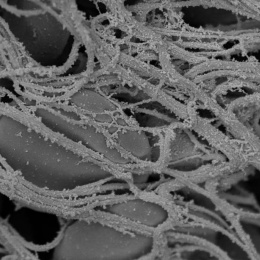Blood Vessel Growth in Healing Wound Tissue
Blood Vessel Growth in Healing Wound Tissue
Submitted by Ben Almquist, Alice Lu, Paula Hammond in the Hammond Research Group at the Koch Institute
Koch Institute at MIT, MIT Department of Chemical Engineering
"On average, one in four diabetics will form a diabetic ulcer, which is a non-healing skin wound that is generally located on the foot. These open wounds pose a serious risk of infection and are a leading cause of non-traumatic lower leg amputation. One reason these wounds form is the disruption of the communication that occurs between cells during normal wound healing. We are developing new wound dressings that reestablish this communication by coordinating the delivery of multiple growth factors (a type of signal cells use to communicate). One goal of these dressings is to promote the growth of new blood vessels in the wound, which many times are lacking in diabetic individuals. These vessels play a crucial role in wound healing, bringing nutrients, oxygen, and a variety of cells to the wound to stimulate the repair process. This photograph is of treated wounds from diabetic mice and show the formation of functional vasculature (green) in the healing wound tissue. We are examining how our dressings that temporally coordinate growth factor delivery impact the formation of new, functional vasculature in the healing granulation tissue (new tissue that fills in wounds)."





